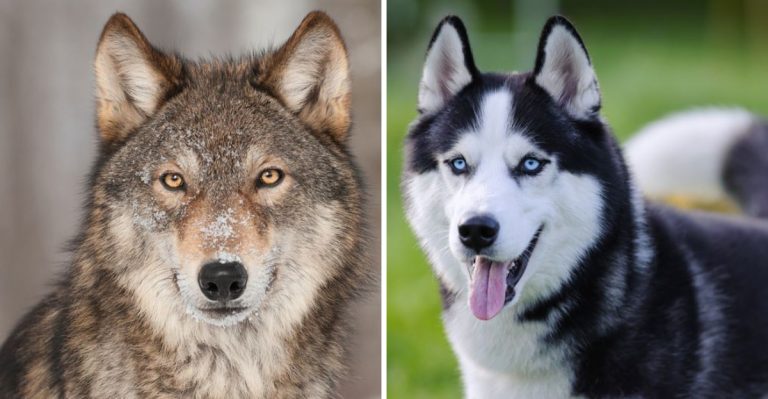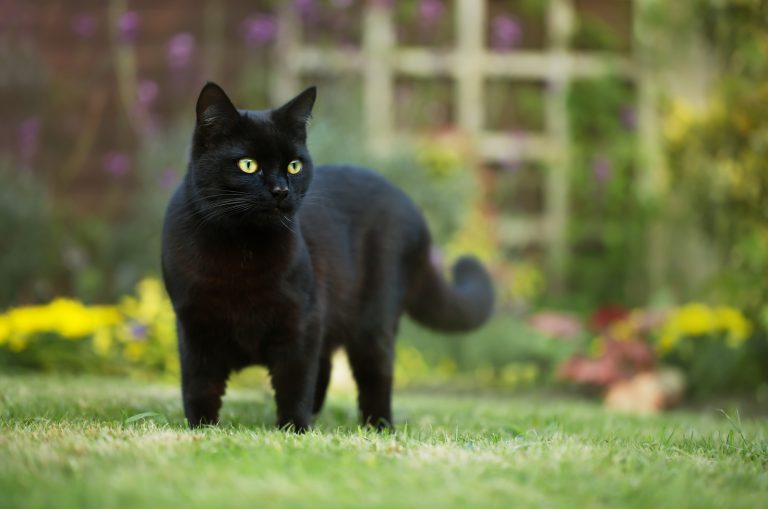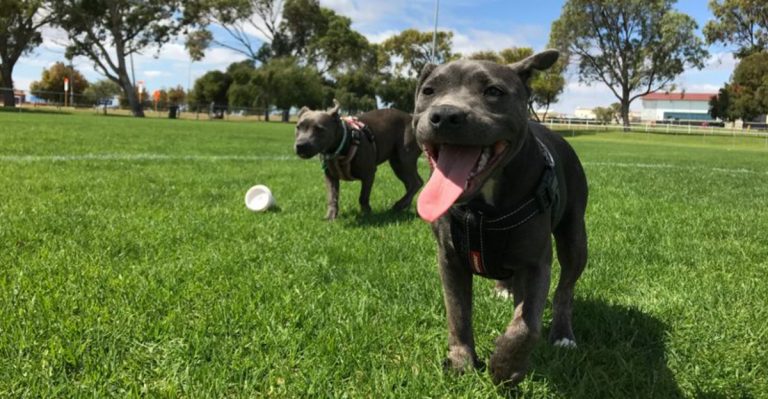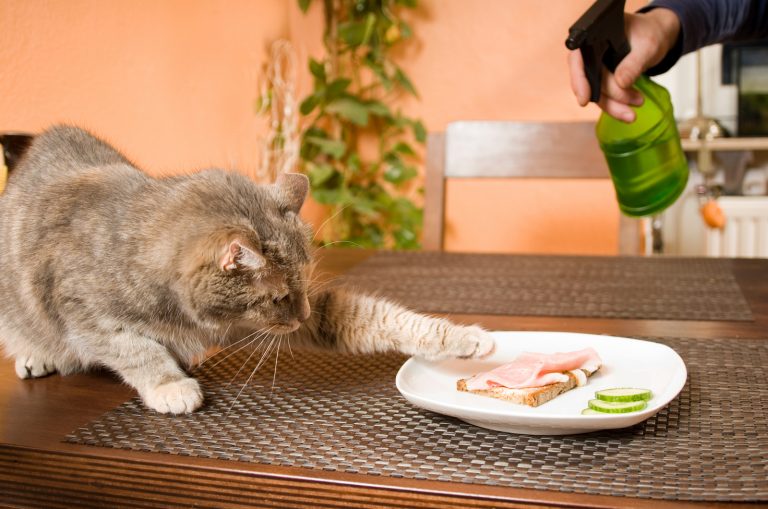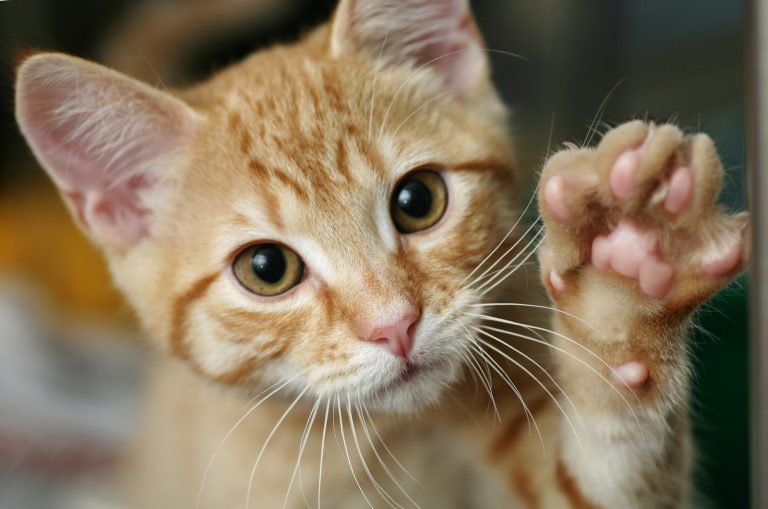Why Do Cats Tails Puff Up? 7 Reasons That Might Surprise You
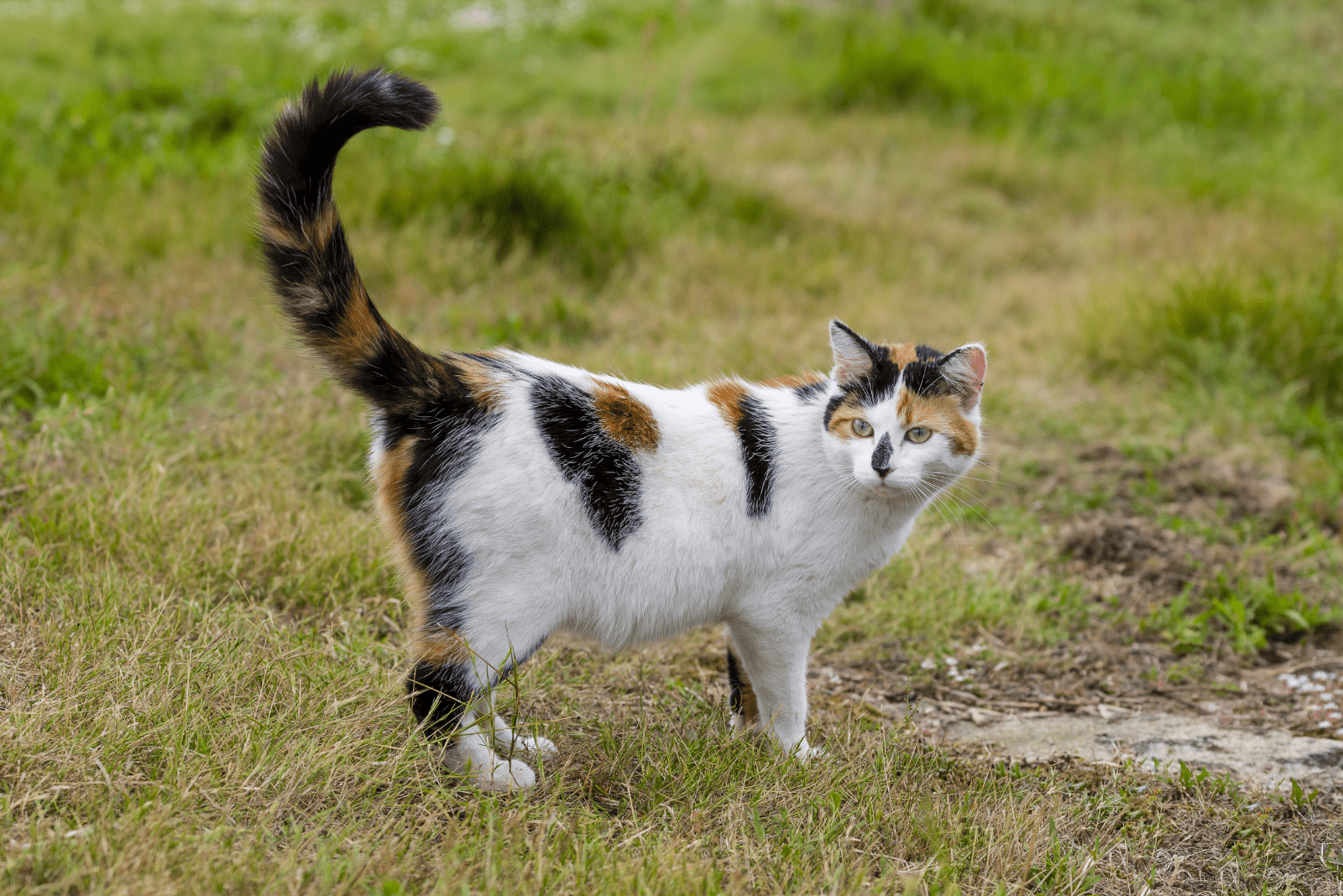
Many of us consider cats to be very mysterious creatures. I often find myself wondering What on earth is my cat thinking? Since I cannot read my cat’s mind, like every other cat owner, I rely on interpreting their behavior and body language.
As cats cannot verbally express how they feel, they have become adept at conveying their feelings through their body language. One way they do this is by fluffing up their tails. But what does this action really mean? Why do cats tails puff up?
Cats fluff up their tails as a reaction to something happening. For example, if they’re startled by a car’s headlight, scared by a loud noise, irritated or frustrated while playing, angry, in attack-mode, intimidated by more dominant cats, feeling excited, or even if they are simply cold!
Understanding why a cat is fluffing up their tail will help the cat owner understand their cat’s behavior so they know when to intervene. Sometimes, owners will need to step in and help their cats calm down, while other times that is not necessary.
Continue reading to find out 7 common reasons cats puff up their tails and what you can do about it!
Why Do Cats Tails Puff Up? Piloerection Explained
Piloerection is essentially then the hairs of the cat’s shoulders, back, and tail elevate from their body. In this case, we are interested in the hair of the cat’s tail standing up. It could be said that piloerection for cats is like goosebumps for humans.
The nervous system is responsible for this uncontrollable, hair-raising reaction. The muscles contract as a result of adrenaline, and the hair straightens away from the body.
Even though piloerection may not be obvious in cats with short, thick coats, it still occurs naturally – we are just not as aware of it as we would be in a cat with longer hair.
What Is The Purpose Of This Hair-Raising Involuntary Reaction?
The answer to this question is very simple – the goal is to make the cat appear larger than they really are! When the hairs of the tail raise up, the tail gains volume and the cat appears more daunting to potential predators.
Generally speaking, a cat’s puffed up tail is a sign that the cat is trying to avoid interaction. That extra-fluffy tail is signaling “Leave me alone!”.
Let’s look at the most common reasons for cats puffing up their tails!
7 Reasons For A Cat’s Puffed Up Tail
Below, I’ve listed and explained the most likely reasons for this strange aspect of your cat’s body language.
It’s always easier to work out your cat’s thoughts when you consider their body language as a whole. This means it is important to keep an eye out for other clues your cat might be displaying that give you insight into how it is feeling.
1. Your Cat Has Been Startled
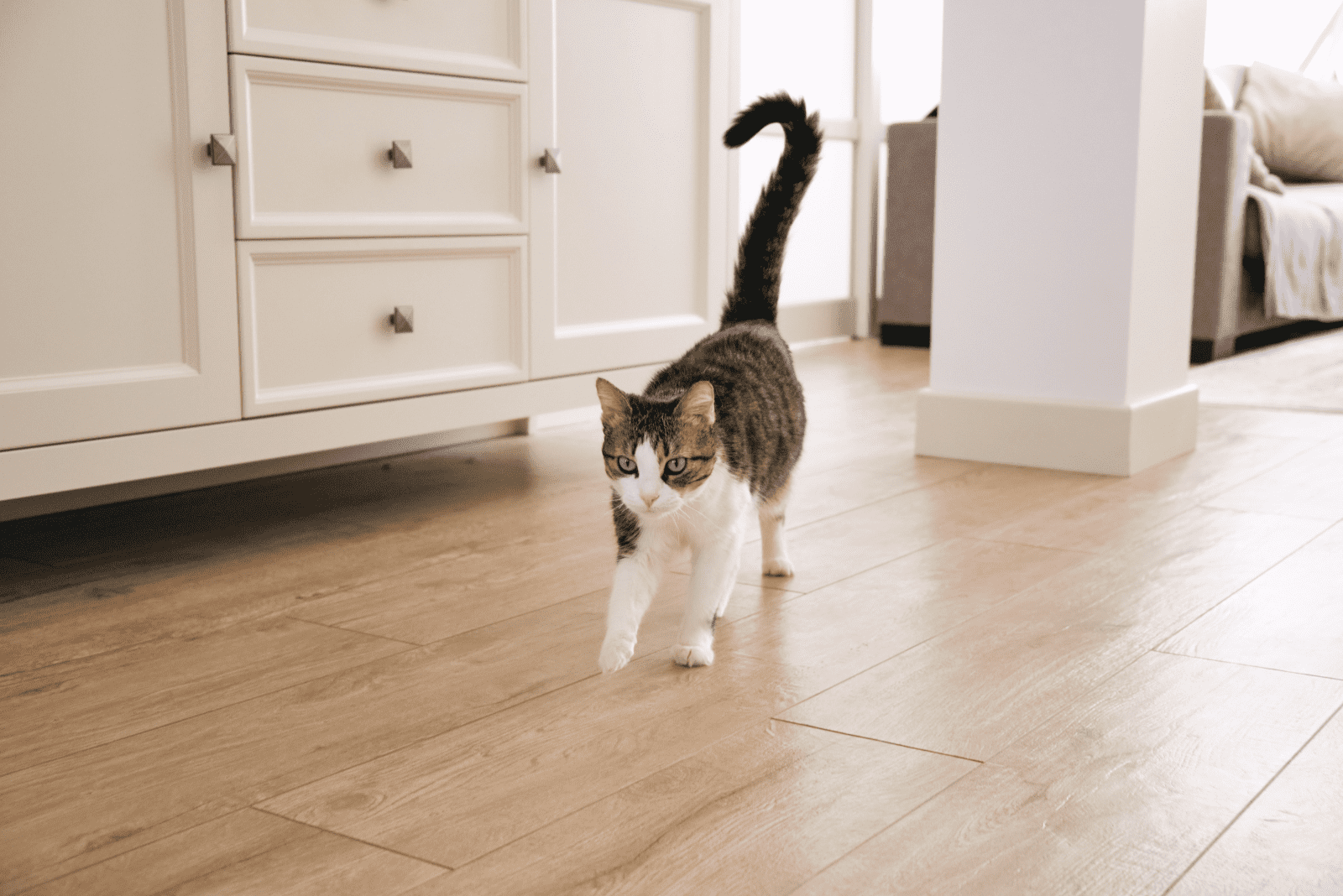
When a cat gets startled, it will most likely display that famous halloween cat pose. If you’re not familiar with what the halloween cat pose is, it’s when a cat has their eyes wide open, an arched back and a puffed up tail that also curls like a question mark.
If you see your cat’s tail puff up suddenly, it may be that your cat was caught off guard by something and this suddenly scared them.
What can startle a cat?
• Sudden noises (such as car horns, fireworks, slamming doors, etc.)
• Sudden appearance of bright light (such as headlights from a car, turning the light on in a dark room, etc.)
• Sudden movement (such as another cat jumping out from the bushes, or even you suddenly uncrossing your legs, etc.)
The famous halloween cat pose that includes the puffed up tail is a reflex action that occurs when a cat is taken by surprise by a sudden noise, light, or movement.
There is a difference between being startled and being scared. Despite the phrase “scaredy-cat”, cats are not easily scared (they are pretty brave actually!), but they do get startled easily.
2. Your Cat Is Scared
If a cat’s tail is not pointing up, but is rather lowered and puffed up, a very likely explanation is that your cat is scared or even terrified.
What can cause a cat to get scared?
Most cats will get scared in the following instances:
• Another animal being nearby, such as a neighbor’s dog
• Other types of animals in the backyard (such as a raccoon)
• New people entering the house
• Very loud noises (such as power tools, motorcycles revving, vacuuming, etc.)
• Being splashed by water
Establishing that your cat is scared is not always easy (they do like to hide their weaknesses), so you’ll need to be on the lookout for some other signs. In order to do so, you will need to read your cat’s body language.
Body language hints that your cat is scared include:
• Having their eyes wide open with enlarged pupils
• Flattened ears
• Tail wrapping around their body
• Being close to the ground, crouching low
• Maybe even meowing
3. Your Cat Is Feeling Aggressive

A cat will sometimes signal to you that they’re becoming angry and that any threat or opponent should retreat by puffing up its tail and holding it entirely erect in the air.
As previously mentioned, puffing up the tail makes the cat appear larger than they are. For cats, a larger size means more dominance; hopefully it can warn enemies not to come any closer and thus avoid a confrontation.
When cats are threatened, they can either become scared or become aggressive. Puffing up the tail is an instinctive, reflex behavior that, in this case, says “This is mine!” or “Do not come any closer!”.
Signs that a cat is feeling aggressive include:
• Puffed up tail
• Having their entire body puffed up
• An arched back
• Flattened ears
• Yowling
• Hissing
Cats are not very aggressive animals by nature, but they definitely can be aggressive on occasion. When threatened, they display their hostile side. The “threat” doesn’t have to be an objective, real-life threat – it’s anything your cat considers to be a threat.
For example, a cat might even find young kids to be a threat, even though they’re not. For cats, a threat is anyone who could impact their overall wellbeing, claim their territory or compete for their food and water.
4. Your Cat Is In Attack-Mode
When needed, cats can enter attack-mode. You won’t often see a cat being very aggressive and defensive, but it can happen. Cats are very territorial creatures and are ready to defend anything they consider theirs, any time of the day!
Most cats would rather make extremely dramatic bluffs than actually engage in combat. Fighting is a last resort in the event that neither opponent yields.
Nevertheless, one of the biggest tell-tale signs a cat is in an attack-mode is having their tail puffed up and an arched back. Usually, a cat’s tail puffs up to twice its size! This makes the cat look bigger, stronger, and scarier. The same goes for the cat’s arched back – by making them look bigger and more agile, they can intimidate an opponent with the aim of making them go away.
Other signs a cat is going to attack are flattened ears, eyes being wide open, tail swishing, as well as verbally displaying their anger by growling and hissing. If the cat has decided to attack, they will pounce suddenly and you can have a cat fight to deal with!
5. Your Cat Is Intimidated
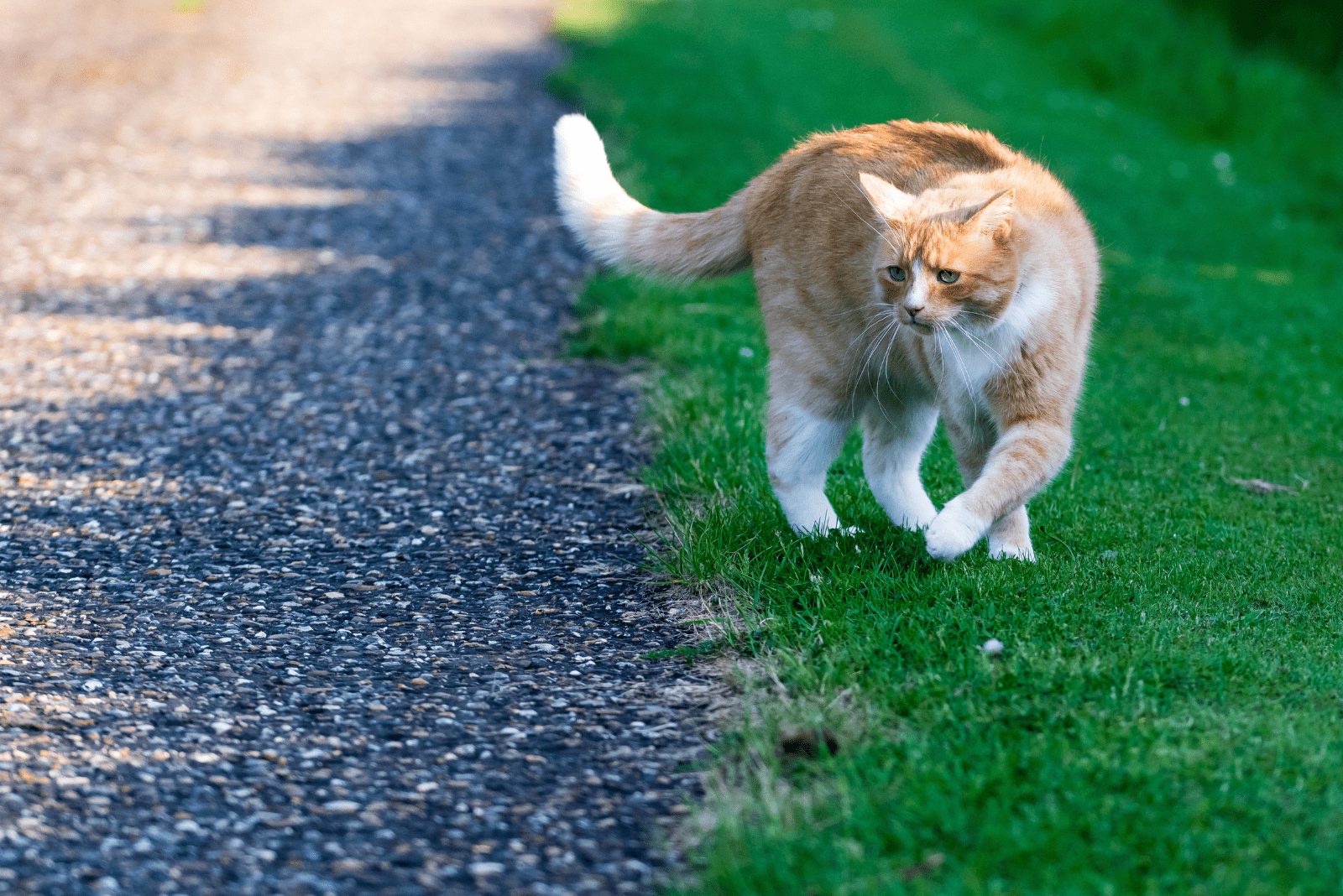
A cat’s puffed tail can also mean a cat is intimidated. Puffing up the tail can also be a sign of submission. You might observe this when your cat is facing another cat they find very scary for whatever reason. For example, your house cat can be intimidated by the big, bad neighborhood stray if they visit your backyard.
When a cat is being submissive due to the presence of a more dominant cat, they tend to puff up their tail and lower it. Sometimes, they might even tuck the tail up between their legs!
The goal of the puffed tail is usually to make the cat appear bigger and more confident in the face of a potential threat. The hair of the tail (and sometimes the entire body) will stand up in reaction to hormone signals from the sympathetic nervous system or the fight-or-flight system; so it can happen when they are aware a confrontation might take place and want to show their submission and avoid a fight.
6. Your Cat Is Cold
This might surprise you, but sometimes, a cat’s puffed up tail simply means the cat is cold! This is not very common but it is a possible reason for a cat’s puffed up tail.
Why do cats puff up their tails when they’re cold?
When the hair of a cat’s coat is standing up, it traps air and acts as insulation to help retain body heat. As you already know, retaining body heat is crucial for survival in the cold and a puffed up tail (and rest of the body) can help a cat when they are experiencing cold temperatures.
7. Your Cat Is Excited
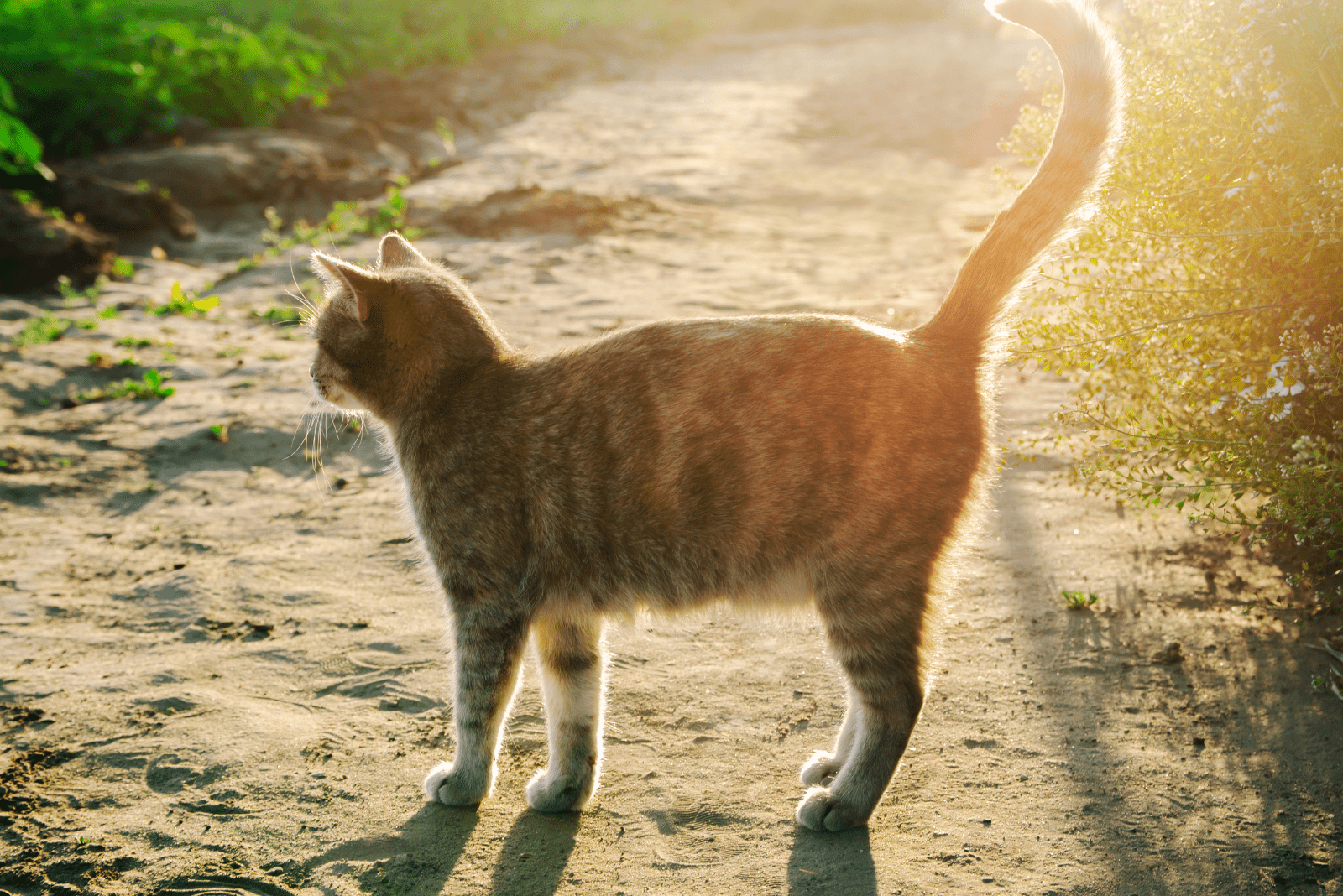
When cats are excited, they are usually in the mood for running and playing around, making trouble. They especially like playing with each other, and one of their favorite tricks is to scare each other.
When a cat is playing by itself, they can still get themselves into situations that may cause the hairs on their tail to rise up. For example, have you ever seen a cat suddenly spot themselves in a mirror?! Their playtime might even involve scaring themselves on purpose! Let your cat continue playing and enjoying its bushy-tailed excitement; this is perfectly normal.
Although this type of play is more common in kittens and young cats than in adult cats, it is a sign of a happy cat!
Other signs your cat is excited are:
• Erect ears
• Tail wagging
• Dilated pupils
What Should I Do When My Cat Fluffs Up Their Tail?
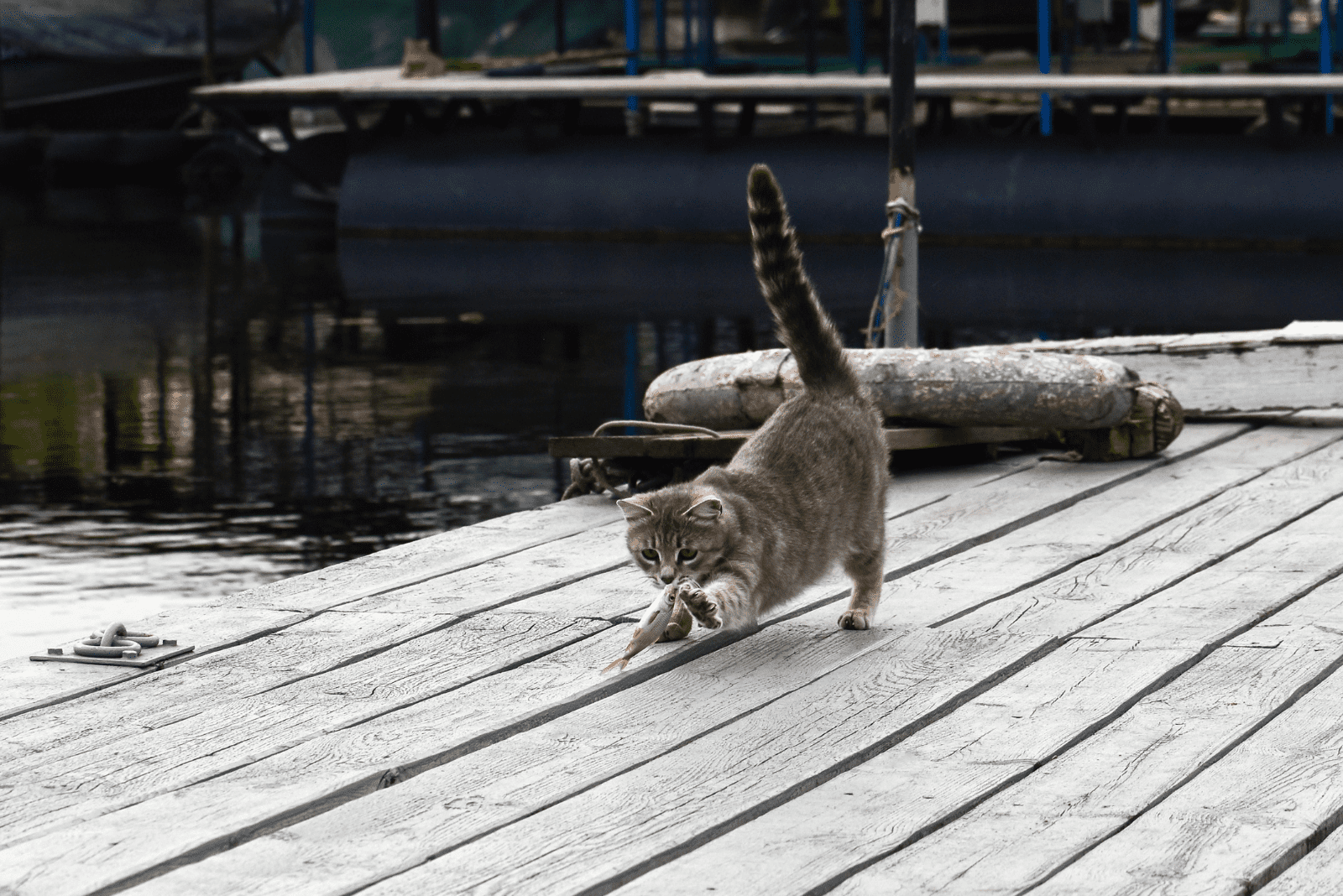
Now that you know the answer to Why does my cat fluff up their tail?, you might be wondering: Is there anything I should do when I notice my cat displaying their puffy tail?
1. Let Your Cat Calm Down On Their Own
Piloerection is not a sign that your cat feels safe or secure. A cat’s tail and body hairs being straight up usually indicate that the cat is startled, scared, angry, aggressive, and ready to attack.
In these situations, the cat is usually agitated and it’s best to let them calm down on their own. Unless you determine that you need to intervene and prevent a potential cat fight, for example. Simply give the animal some time to settle down before you approach them.
Cats do not stay agitated for long, and will be back to their daily activities in no time. However, during that time, it’s not a good idea to try to touch your cat, as they are very sensitive and might misdirect their aggression and attack you.
2. Keep Your Cat Away From The “Threat”
A “threat” here is anything your cat thinks of as a threat; it might not pose an actual threat to your cat at all. Of course, sometimes, your cat might experience a serious threat, such as an aggressive raccoon in your backyard or a stray cat ready to attack when stealing your cat’s food.
If you feel that your cat is facing a serious threat, and this is why they are puffing up their tail, it’s best to remove your cat from the situation and prevent confrontation. This ensures that your kitty leaves unharmed, and your cat’s health is the most important thing.
Cat care can sometimes entail removing a “threat” from your home too. For example, one of my foster cats got really aggressive around the robot vacuum; she would always attack it as soon as it started working. So, I simply didn’t use it while I was fostering that cat – problem solved!
3. Do Not Force Interaction
If a cat is extremely upset or agitated, it’s best not to force interaction. Cats are similar to humans in many ways, and this is one of them. Most people also don’t like being forced to interact when they’re angry or scared.
Feline body position, as well as behavior and other little quirks can tell us owners what our cats are experiencing. If your cat’s tail is puffed up and is swishing left and right while their back is arched, it’s probably not the best time to run towards your cat and pick them up and play with them.
Angry cats don’t like to be touched, petted, or cuddled and if you try to do so, this might end up in the cat attacking you or giving you a few scratches on your hand (which none of us want).
It’s best to leave them alone for a bit and let them cool down if they are startled, scared, angry, aggressive, etc.
4. Provide Your Cat With Their Own “Safe Space”
Some cats get startled, scared, or intimidated easily. That is never a positive thing for the cat and is bound to make them feel upset or anxious. If a cat experiences this a few times throughout the day, it is a good idea to make sure they have their own “safe space”.
For example, you can buy your cat their very own cat tree with a kitty condo. It’s designed to be comfortable and cozy, and will provide your cat with a safe space from anyone and anything that can upset them. It’s also recommended for cats that get stressed easily or are aggressive so they can simply go to their own condo to calm down.
I’m sure that in no time at all, your cat will be back to purr and wiggle their little tail beside you after they’ve relaxed for a while.
FAQ
What Are Some Possible Reasons A Cat’s Tail Might Puff Up?
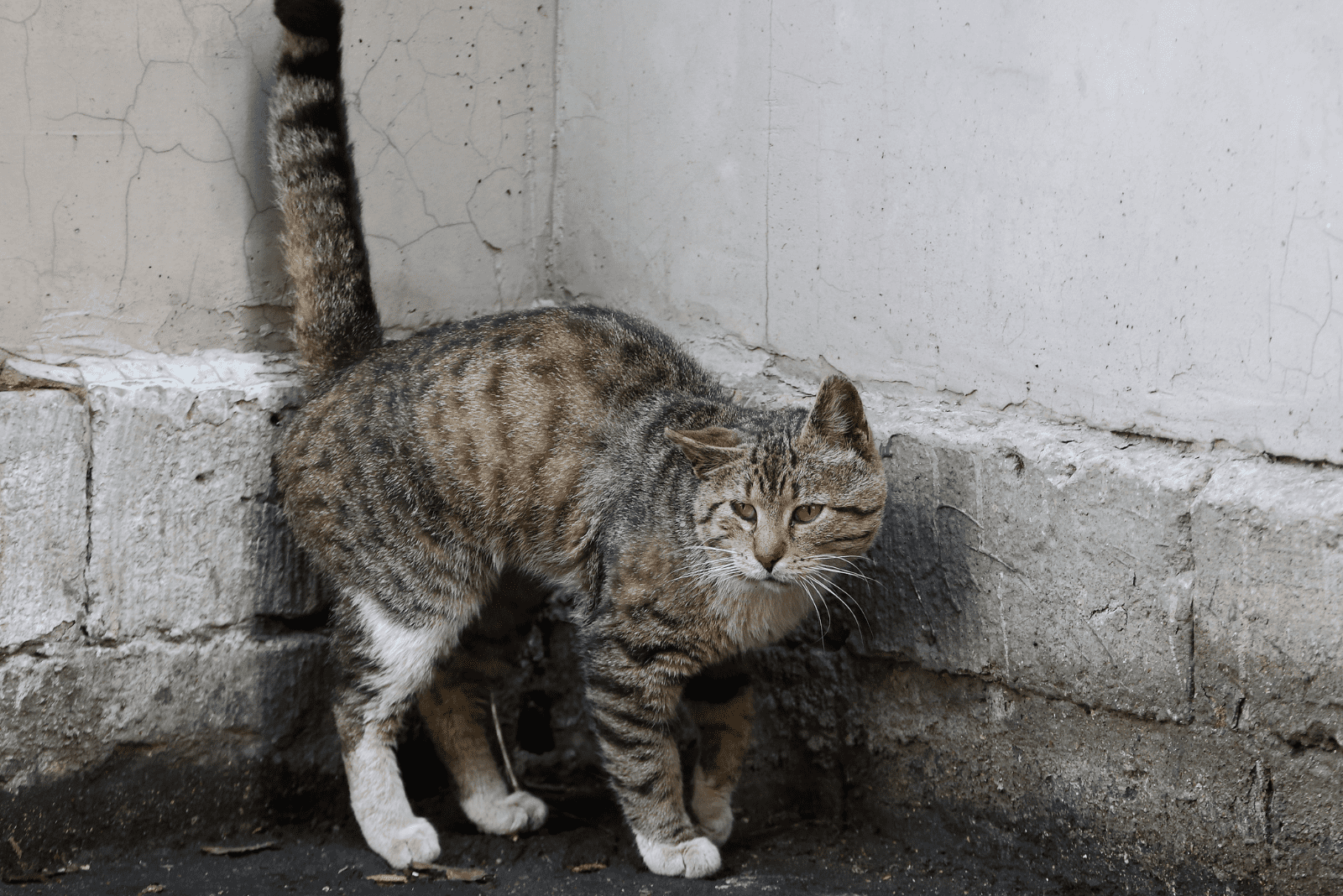
If you’re wondering Why is my cat’s tail puffed up?
Common reasons for a cat’s tail to puff up include:
• Cat being startled
• Cat being scared
• Cat being aggressive
• Cat being in attack-mode
• Cat being intimidated
• Cat being cold
• Cat being excited
What Is The Primary Function Of A Cat’s Tail?
The primary function of a cat’s tail is to help them balance. For example, if a cat is walking on the edge, you will notice their tail changes position as a way to help them maintain balance and keep walking the narrow path.
The tail is also used for communicating. It signals the cat’s mood and intentions.
Examples of how a cat’s tail is used for signaling and communication include:
• An erect tail means a friendly greeting
• Slightly raised and curved tail means a cat is intrigued
• Tail tucked between the legs means a cat is very scared
• Tail swishing means you’re dealing with an aggressive cat which is in attack-mode
What Is The Tail Used For When Cats Are In Danger?
When cats are in danger, they use their tails to tell the aggressor “You need to get away from me!”. To do this, their tail puffs up to twice its normal size, efficiently making the cat appear bigger. In the animal world, a larger size means the animal is more intimidating, and this can potentially make the aggressor give up and help the cat to avoid a confrontation.
How To React To A Cat’s Tail Puffing Up?
Most of the time, people should not get involved in situations where the cats are displaying their puffed up tail. This is because a puffy tail is rarely associated with happy emotions; it usually means a cat is scared or aggressive. In this state, it’s best to let the cat calm down on their own.
In some instances, such as when your cat encounters another cat and you see both of their tails puff up and they have their backs arched signaling they’re both in attack-mode, it’s best to intervene and separate the cats in order to prevent a cat fight.
In Conclusion
Cats have very expressive bodies and a cat’s tail, fur, and body language help us humans determine what our feline friends are thinking and experiencing. An interesting thing cats do is puffing up their tail and if you’re wondering Why do cats tails puff up?, here is your answer:
The reason for a cat’s puffed up tail is that they have been startled (by a car’s headlights, for example), got scared (by a loud persistent noise such as power tools, for example), are feeling aggressive or in straight-up attack mode, are intimidated (by another cat, for example), are cold, or even just excited!
Puffy tails are much more easily observed in long-haired cat breeds (their tails puff up twice the size!), but short-haired breeds display it too. Although it looks a bit strange, their tails tell us a lot about the emotional state and intentions of the cat. If you watch the rest of the body and note any other behavioral signs a cat is displaying, you can get to the bottom of what they might be thinking.
I genuinely hope you liked this article and have learned something new. Now you can go and try to decipher what your cat might be thinking when they puff up their tail!

